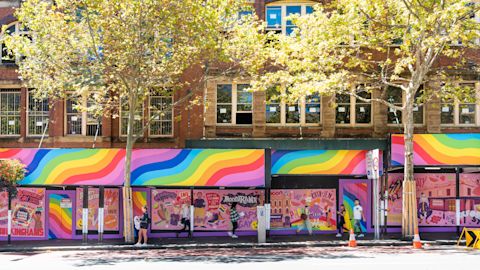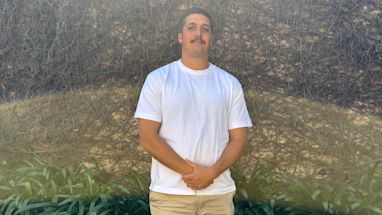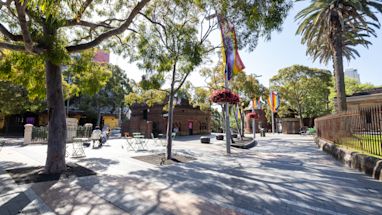We commissioned Sydney queer artist Amy Blue to create a fantastic artwork and brighten up buildings under construction.
The hoardings have been installed at the Ashe Morgan/TOGA development sites.
We asked Amy a little bit about this project and how she came up with it.

Tell us a bit about yourself. And broadly, how would you describe your art?
I’m a multidisciplinary artist creating works connected to my personal queer history, as well as documenting the current pop culture I’m consuming. As pop culture shifts and changes, so does the style and the focus subjects of my work. But regardless of the illustration style or subject matter, the works are all connected to my identity as a queer artist and the relationship I have with the LGBTIQA+ community.
Describe what you’ve created and the creative process to reach the final product.
Oxford Street is instantly recognisable by the rainbow flags that proudly decorate the strip. But the people, places and things that have made Oxford Street a place of immense historical importance to the community have consistently changed over the decades.
Now, Oxford Street is entering a new era, and what better way to celebrate this moment in history than with an illustrative representation capturing 'The A–Z of Oxford Street’ … a sort of ‘GAY-B-C’, if you like!
I wanted this collection of illustrations to capture a snippet of some of the people and events that have illuminated Oxford Street throughout its brilliant and colourful history. As a community we have experienced moments that call for triumph and celebration, but we have also faced some extremely challenging moments of adversity.
This collection is a nod to some of the defining moments in that history, and it was really important to me to acknowledge those who paved the way for us before, and those who continue to do so today.

How did you come up with the idea for the concept?
It was one of those things where the simplest ideas are often the best. Our ABCs are one of the first things we learn and it’s a concept that is accessible to lots of the audience. In my initial concept, I wanted to incorporate the history of Oxford Street in an alphabetised collection of illustrations that stretched along the street in order, from A to Z.
While that layout has changed and it is no longer in alphabetical order, what has remained is a collection of illustrations that encapsulates everything I could possibly think of that is connected to Oxford Street.


The concept covers a huge amount of the queer community’s history, as well as historical buildings and shops that have come and gone, and even the trams and buses that have ferried passengers along the street throughout the decades.
The people, places and things I have depicted in the illustration have all helped shape how we understand the area today, and how we will remember it as it continues to change.
When you’re creating something that touches on some painful history, it’s important to retell it in an open way, that doesn’t isolate anyone from understanding. It was a daunting task to create a work that speaks to the sometimes harrowing history of the site, but is also reflective of the light and colour that we’ve come to associate with Oxford Street.

Why did you want to get involved in this project?
Being involved in this project has been a true honour, and a highlight of my career so far. In 2017 I made a conscious decision to change the direction of my creative practice to create works that speak to the LGBTIQA+ community, works that reflected a lived experience, and works that were recognisable to queer people.
As a member of this community myself, I think it’s really important that creators with some lived experiences of the issues involved in this sometimes harrowing history are the creators who are documenting and retelling these stories. I hope the LGBTIQA+ community can see themselves reflected in my work.
What does it mean to you to have your artwork featured on Oxford Street, especially on this scale?
It’s definitely the biggest piece of work I have ever done. And I do work to quite a small scale in my work generally – so it is funny to see my work depicted on such a huge scale!
I’m just so proud for my work to be projected on this scale and to be part of a global event with WorldPride, and of course Mardi Gras. I feel really lucky.

How do you hope the art will be received by the community?
The LGBTIQA+ community is so important to me. Being a part of this community has helped shape me into the queer person I am today. It is such a privilege to not only be asked to create an artwork to this scale, but to be asked to represent a group of people that have been such a big part of my life.
The LGBTIQA+ community are who I have made this work for, so it’s so important to me that this work speaks to them. I want people to see themselves in this work and I want people to feel seen. I think one of the main hurdles being a part of the LGBTIQA+ community is not feeling validated or being able to exist outside of queer spaces.
It’s so important to see yourself reflected through art and having something to this scale is a step in the right direction.
Sydney WorldPride 2023 is on from 17 February to 5 March 2023 incorporating Sydney Gay and Lesbian Mardi Gras. Access tickets for events at the official SydneyWorldPride site. Find tickets for community events at Pride Amplified.
Published 8 December 2022, updated 2 March 2023



